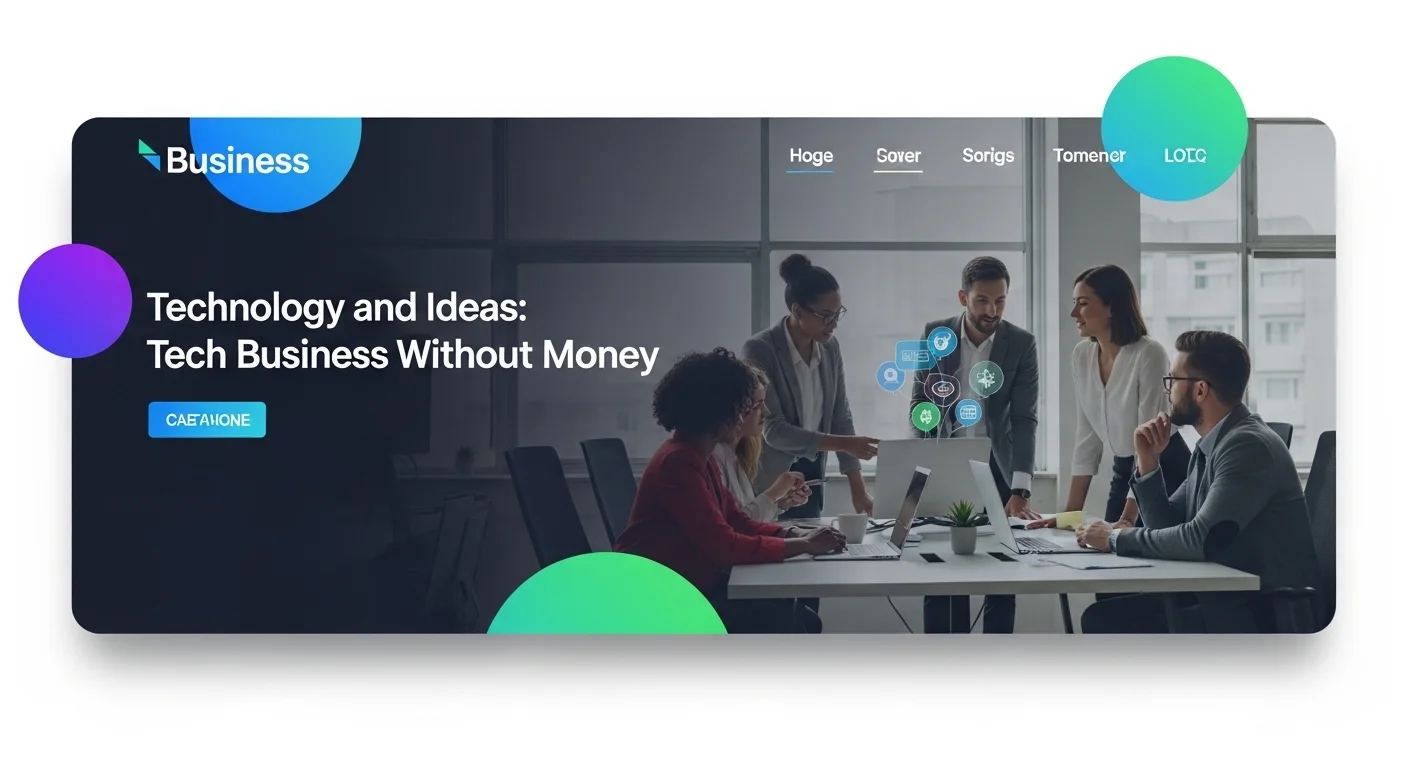Launch Your Tech Startup with $0: A Founder's Guide

Executive Summary
In my years in the tech world, I've seen countless brilliant ideas fizzle out for one reason: a lack of funding. But what if I told you that cash isn't king anymore? In today's digital age, you can build a thriving tech business with virtually zero initial investment. It’s all about being resourceful. This guide is my personal playbook, built from experience, on how to do just that. We'll walk through how you can leverage free cloud services, open-source software, and powerful AI tools to turn your idea into reality. Forget chasing venture capital; your most valuable assets are your skills, your time, and your creativity. This is for the aspiring founder working a day job, the developer with a side project, and anyone who believes a great idea is worth more than a big check. Let's explore how to build something amazing from the ground up.
Table of Contents
Table of Contents
What is Bootstrapping and Why It Matters in Tech
Let's get one thing straight: starting a business 'without money' isn't magic. It's a strategy. We call it 'bootstrapping'—building a company from personal resources, with little to no external funding. At its heart, it's about trading financial capital for intellectual capital. Instead of writing checks, you're writing code, designing interfaces, and building relationships. For years, the tech industry felt like a private club, open only to those with venture capital connections. Bootstrapping has kicked the door wide open. It democratizes innovation, proving that a great idea paired with skill and determination can compete with the giants. Technology itself is what makes this possible. With open-source software, 'freemium' tools, and global digital platforms, the financial barriers that once stood in your way have crumbled.
The beauty of this approach is the explosion of viable business ideas it creates. I remember piecing together my first app using a free code editor, hosting it on GitHub, and deploying it on a free cloud plan. The entire journey from concept to a live product cost me nothing but my time. This opens up a world of possibilities for developers, designers, and marketers. The goal isn't to impress investors; it's to build something genuinely useful that people will love. Once you have users and, ideally, paying customers, you can reinvest that revenue back into the business, creating a powerful, self-sustaining growth engine.
The Power of Sweat Equity and Your Own Expertise
In a bootstrapped venture, your 'investment' is measured in hours, not dollars. We call this 'sweat equity'—the value you create through your own hard work. It’s the late nights spent debugging code, the weekends dedicated to marketing, the relentless effort to build something from nothing. This personal stake is what gives your project its initial worth. Your other superpower is your 'intellectual capital'—your unique knowledge and skills. Maybe you're a wizard with a specific programming language, an expert in cybersecurity, or you've devised a brilliant new algorithm. In the early days, this expertise is far more valuable than a pile of cash. For instance, a cybersecurity pro can launch a consulting firm with just a laptop and their brain. They can offer services like security audits or policy reviews—pure knowledge work. This is a perfect example of a business built on expertise, where the service itself is the product.
One of the biggest advantages I found in bootstrapping is freedom. When you take on investors, you're often pressured to grow at all costs, which can lead to bad decisions and burnout. By growing organically, you maintain 100% control. You can pivot on a dime, listen to your gut, and run a lean operation that minimizes financial risk. It's the perfect way to test a business idea on the side while keeping your day job. This slower, more intentional path often builds a more resilient and authentic company in the long run.
Using Today's Tech to Build for Free
Today's technology landscape is a goldmine for bootstrappers. Cloud platforms like AWS, Google Cloud, and Azure offer generous free tiers that can run your entire startup for the first year or even longer. They give you everything from web hosting and databases to cutting-edge machine learning tools. A decade ago, accessing this kind of power would have cost a fortune. Now, an AI startup can train its models on powerful servers for free.
Open-source software is the other pillar of the no-cost startup. From Linux to WordPress and React, the community provides the essential building blocks for almost any digital product imaginable, saving you a fortune in licensing fees. And it doesn't stop there. The rise of no-code platforms like Bubble and Webflow means even non-technical founders can build complex apps and websites without writing a single line of code. These tools are incredible for quickly creating a prototype, getting it in front of users, and seeing if your idea has legs before you invest heavily. By combining these technologies, building a business without funding is no longer a dream; it's a practical, proven path to success. It’s about being clever and resourceful, and it’s shaping a more creative and inclusive future for everyone in tech.

The Zero-Budget Startup Playbook: From Idea to First Dollar
Alright, let's get practical. Starting a tech venture on a shoestring budget isn't just about having a great idea; it's about having a smart plan. This is the playbook I've used to turn concepts into cash-flowing businesses without taking a dime of outside money. The core philosophy is simple: use what's free, focus on value, and be relentlessly resourceful. Here’s how you can do it too.
Step 1: Choose a Business Model That Works Without Cash
Your first move is to pick a business model that's naturally lean. You're looking for service-based models or digital products you can create and sell with no overhead. From my experience, these are the best bets:
- Freelancing and Consulting: This is the fastest way to get revenue in the door. If you have a skill—web development, UI/UX design, cybersecurity, SEO—you have a business. I started by finding my first clients on platforms like Upwork. My only 'investment' was my portfolio and the time I spent writing compelling proposals. My advice? Get specific. Don't just be a 'web developer.' Be the 'go-to expert for speeding up e-commerce websites.' Specificity cuts through the noise.
- Content and Education: Are you an expert in something? Teach it. This is a phenomenal side hustle that can grow into a full-time business. I started by writing a blog, sharing everything I knew about a niche tech topic. You can start a YouTube channel, a podcast, or a newsletter on Substack for free. Monetize with ads, affiliate marketing (recommending tools you actually use and love), or by eventually selling your own e-books and courses. The startup cost is effectively zero.
- Niche Software as a Service (SaaS): This is the high-growth play. Find a very specific problem for a small group of people and build a tool to solve it. But don't hire a team of developers. Use no-code tools like Bubble to build your first version (your MVP, or Minimum Viable Product). Host it for free on a cloud provider's starter tier. Offer a limited free plan to get users in the door and collect feedback, then charge for a premium version with more features. You validate your idea before you write a single check.
- Open-Source with a Service Layer: If you love to code, build a useful open-source tool and share it on GitHub. As it gains popularity and companies start using it, you can offer paid support, custom development, or consulting to help them implement it. This model is brilliant because it builds your reputation and a loyal community first, then monetizes your expertise.
Step 2: Build Your Free Tech Stack
Once you have a model, you need your tools. This is your 'no-cost' tech stack, the digital equivalent of a workshop. Here are my go-to resources:
- Code & Development: Visual Studio Code is the best free code editor, period. Host your projects in free private repositories on GitHub or GitLab.
- Hosting & Cloud: This is your biggest money-saver. The AWS Free Tier, Google Cloud Free Tier, and Azure for Startups program are game-changers. For simple websites and web apps, you can't beat the free hosting from Netlify, Vercel, or GitHub Pages.
- Design: Figma is the industry standard for UI/UX design, and its free tier is incredibly generous. For social media graphics and presentations, Canva is fantastic. Forget Photoshop; use GIMP for free, powerful photo editing.
- Project Management: Keep your thoughts and tasks organized with the free plans from Trello, Asana, or Notion. They're perfect for solo founders.
- Marketing & Communication: Start a blog on Medium or a newsletter on Substack to build your audience. Use Mailchimp's free plan for your first 500 email subscribers. Manage social media with Buffer's free tier. Find your first customers by genuinely helping people on Reddit, LinkedIn, or industry forums.
- AI & Automation: You now have a free intern. Use ChatGPT or Google Gemini for brainstorming, writing first drafts of content, and even debugging code. Automate simple tasks between apps with the free tiers of Zapier or Make.com.
Step 3: Execute and Grow Smart
With your plan and tools, it's time to execute. Your initial goal is momentum. Go above and beyond for your first few customers. Their testimonials are marketing gold. As revenue starts to trickle in, be disciplined. That first bit of profit isn't for a fancy dinner; it's to upgrade your Mailchimp plan, run a small ad campaign, or hire a virtual assistant. Bootstrapping doesn't mean you *never* spend money. It means you only spend the money your business has earned. This path of organic growth builds a strong, resilient company that belongs entirely to you. It's the ultimate reward for your hard work and vision.

Pro Tips for Bootstrappers: How to Thrive, Not Just Survive
Making it work without a safety net of cash requires more than just a good idea; it requires grit and smart habits. This isn't just theory—these are the hard-won lessons from my own journey of building a business from the ground up. Here are my essential tips and strategies to help you not only launch but also build a sustainable and successful tech venture.
Best Practices for Sustainable Growth
Discipline is your co-founder when you're bootstrapping. These practices will keep you focused and help you build something that lasts.
- Become Obsessed with a Niche: Don't try to build the next Facebook. Instead, build something for a small, underserved group of people. For example, instead of a generic CRM, what about a CRM built specifically for freelance photographers? When you focus on a niche, your marketing becomes easier, your product development is more targeted, and you can become the undisputed expert in that small pond. That expertise is your moat.
- Build in Public: This was a game-changer for me. Share your entire journey—the wins, the failures, the 'aha!' moments—on platforms like X (Twitter) or LinkedIn. This transparency builds an authentic connection with your audience. People will root for you, offer feedback, and become your first customers because they feel like they're part of your story. It’s the most powerful, and free, marketing you can do.
- Launch an MVP, Not a Masterpiece: Your first version should be simple. It needs to do one thing well. That's it. I know the temptation to add 'just one more feature,' but you have to resist. Launching a Minimum Viable Product (MVP) quickly is crucial for getting real-world feedback. That feedback will tell you what to build next far better than your own assumptions ever could.
- Treat Your First 10 Users Like Gold: These people are your true believers. They took a chance on you. Talk to them. Get on a call. Find out what they love, what they hate, and what would make them tell their friends about you. Their insights are priceless. They will help you find product-market fit.
- Embrace 'Good Enough': When you're a one-person show, perfectionism is your enemy. Your website design, your blog post, your new feature—it doesn't have to be perfect. It has to be 'good enough' to ship. You can always iterate and improve later. The most important thing is to maintain momentum.
Essential Tools and Strategies
The right strategy can be a massive force multiplier. Here's what has worked for me:
- Weaponize Your LinkedIn Profile: LinkedIn is so much more than an online resume. It's a powerful lead-generation machine. Optimize your profile to speak directly to your ideal customer. Post insightful content about your niche every single day. Engage in conversations. A strong LinkedIn presence can be your entire salesperson working for you 24/7, for free.
- Play the Long Game with SEO: Start a blog and focus on Search Engine Optimization (SEO) from day one. Use free tools like Google Keyword Planner to find out what questions your target audience is asking, then write the best, most helpful articles on the internet answering them. It takes time, but showing up on the first page of Google is like having a salesperson working for you 24/7, for free.
- Be Genuinely Helpful in Communities: Find out where your target customers hang out online—Reddit, Facebook groups, Slack channels—and become a valued member. Don't just drop links to your product. Answer questions. Offer advice. Build a reputation as an expert who is there to help. People will naturally become curious about who you are and what you do.
Final Thoughts and Next Steps
Remember, you're not alone on this journey. An incredible resource that I constantly revisit is the Y Combinator Library. It’s a treasure trove of essays and videos from the world's most successful founders, and much of the advice on finding an idea and building a great product is perfectly suited for bootstrappers.
Ultimately, building a business with no money is a profound act of creation. It's about being resourceful, resilient, and laser-focused on creating real value for others. The technology available today gives us an unprecedented opportunity to build something global from our keyboards. These strategies aren't just about saving money; they're about building a smarter, leaner, and more authentic business. By embracing this philosophy, you're not just starting a company—you're proving that the best ideas, powered by passion, can change the world.
Expert Reviews & Testimonials
Sarah Johnson, Business Owner ⭐⭐⭐
This was a good starting point, but as a small business owner, I was hoping for more real-world case studies I could relate to.
Mike Chen, IT Consultant ⭐⭐⭐⭐
A really helpful overview of bootstrapping in tech. It clarified a lot for me, though a couple of the technical sections could be broken down even further for beginners.
Emma Davis, Tech Expert ⭐⭐⭐⭐⭐
Absolutely fantastic guide! As a tech specialist, I found it comprehensive and spot-on. It connected all the dots for me perfectly. Highly recommended.



